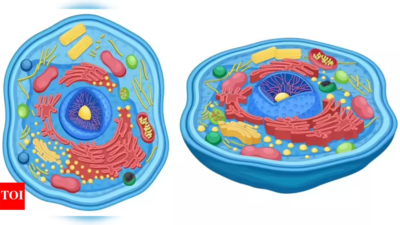ARTICLE AD BOX

MUMBAI: We often imagine cells as tiny chemists—receiving signals, processing instructions, and producing proteins in a flurry of biochemical activity. But what if they were also quiet engineers, silently listening to the architecture around them, tuning in to tensions that stretch and pull, feeling their way into place?A new study from researchers at the Indian Institute of Technology (IIT) Bombay suggests exactly that: that cells don’t just see or hear—they feel.
And more remarkably, they remember. In a soft, silent laboratory, without a single shout of a chemical signal, muscle precursor cells learned to align themselves by sensing an invisible tension underfoot. The finding, published in *Cell Reports Physical Science*, offers a rare and elegant peek into the physical intelligence of life—and was just chosen as among the journal’s best work in biophysics.It’s easy to overlook the poetry in biology. But consider this: the cells in our muscles lie in perfect parallel, allowing them to pull in unison. The ones in our eyes form radial fans that help focus light to a point. Blood vessels curve gracefully toward wounds. Such arrangements are not decorative. They’re essential. Form begets function. But how do cells know where to go? Who—or what—is guiding them?“We’ve long assumed it’s all chemistry,” says Prof.
Abhijit Majumder, who led the study. “That cells respond to growth factors, to gradients, to instructions carried by molecules.” That assumption held for decades. But in recent years, a quiet revolution has been unfolding in the study of mechanobiology—where mechanical forces, not chemicals, do the talking.Cells, it turns out, are tactile creatures. They feel how soft or stiff their surroundings are. They respond to being stretched, compressed, or nudged. They even react to textures far smaller than themselves. “In real tissue, there’s always some mechanical inhomogeneity,” explains Prof. Majumder. “Whether it’s a growing organ, a wound in repair, or even a tumour—there’s tension. The question is, how do cells respond?”To explore this, the IIT Bombay team created a miniature world—a soft gel made of polyacrylamide, inside which they embedded a single glass bead.
Imagine a soft mattress with a marble tucked inside. Now place it in water. As the gel swells, the bead resists. The area around it stretches unevenly, creating a gentle strain gradient—an invisible field of mechanical instruction.Next, they introduced muscle precursor cells—myoblasts—on top of this landscape. What followed was extraordinary. The cells nearest the bead began to align themselves, fanning out radially like sunrays.
Not due to gravity or light or nutrients. Simply because they felt the difference in stretch beneath them.“It was as though they sensed the lay of the land—the pre-strain in the gel,” says Dr. Akshada Khadpekar, the lead author. “And not only did they align, they passed the message outward, organising others farther away.” The effect stretched across a span of 1–2 millimetres—roughly 20 to 40 cell lengths. On gels without a bead, the alignment barely extended 0.35 mm.To ensure this wasn’t due to chemical cues, the researchers ran control experiments. They swapped out extracellular matrix (ECM) proteins, adjusted the stiffness of the gels, and played with surface coatings. Only the softness of the substrate—and the presence of that gentle pre-strain—made the difference. “This ruled out biochemical factors. The alignment was purely mechanical,” confirms Dr. Khadpekar.But how do you prove what you can’t see? That’s where collaboration came in.
Prof Parag Tandaiya from IIT Bombay’s Mechanical Engineering department joined the team to run finite element simulations—computer models that mapped the stress and strain in the gel. The simulations confirmed what the eye could not: the invisible forces the cells were feeling closely matched the patterns of alignment observed.“This was key,” says Prof. Tandaiya. “There’s no experimental way to directly measure these subtle strain fields.
Simulations let us visualise what the cells themselves are sensing.”To test how universal this effect was, the team didn’t stop at one bead. They tried hollow capillaries, bead arrays, and combinations of both. The cells aligned not just in straight lines but in arcs, spirals, and waves—shaped by invisible gradients of tension. Different cell types behaved differently depending on how stretched out they were, or how forcefully they tugged on the surface.“What’s truly fascinating,” says Prof Majumder, “is that cells don’t just respond to strain. They respond to strain direction. They align themselves along the path of greatest stretch, like grass flattening in the wind.”The researchers then used this insight to build a predictive model. By factoring in a cell’s shape, contractile strength, and the stiffness of the substrate, they could estimate how it would align.
A mechanical fortune-teller of sorts—reading the future from the pull of a gel.But the implications are far from academic. In tissue engineering, such findings could allow scientists to shape cell patterns not with chemical scaffolds but with simple, passive designs. In cancer biology, understanding how tumours distort their mechanical environment could help explain how they influence nearby cells. And in regenerative medicine, tweaking the mechanical properties of ageing or injured tissue might help restore normal function.The beauty of this study lies in its simplicity. No expensive chemicals. No fancy equipment. Just a soft gel, a glass bead, and a curious question: What if cells could feel?They can. And they do. “It’s a very intelligent response,” says Prof. Tandaiya. “One that we’re only beginning to understand.” For now, though, the findings sit like ripples on the surface of science—quiet but far-reaching. Because every now and then, in the stillness of a lab, we discover that life has its own sense of touch. And sometimes, that’s enough to show it the way.



.png)
.png)
.png)
















 5 days ago
16
5 days ago
16









 English (US) ·
English (US) ·